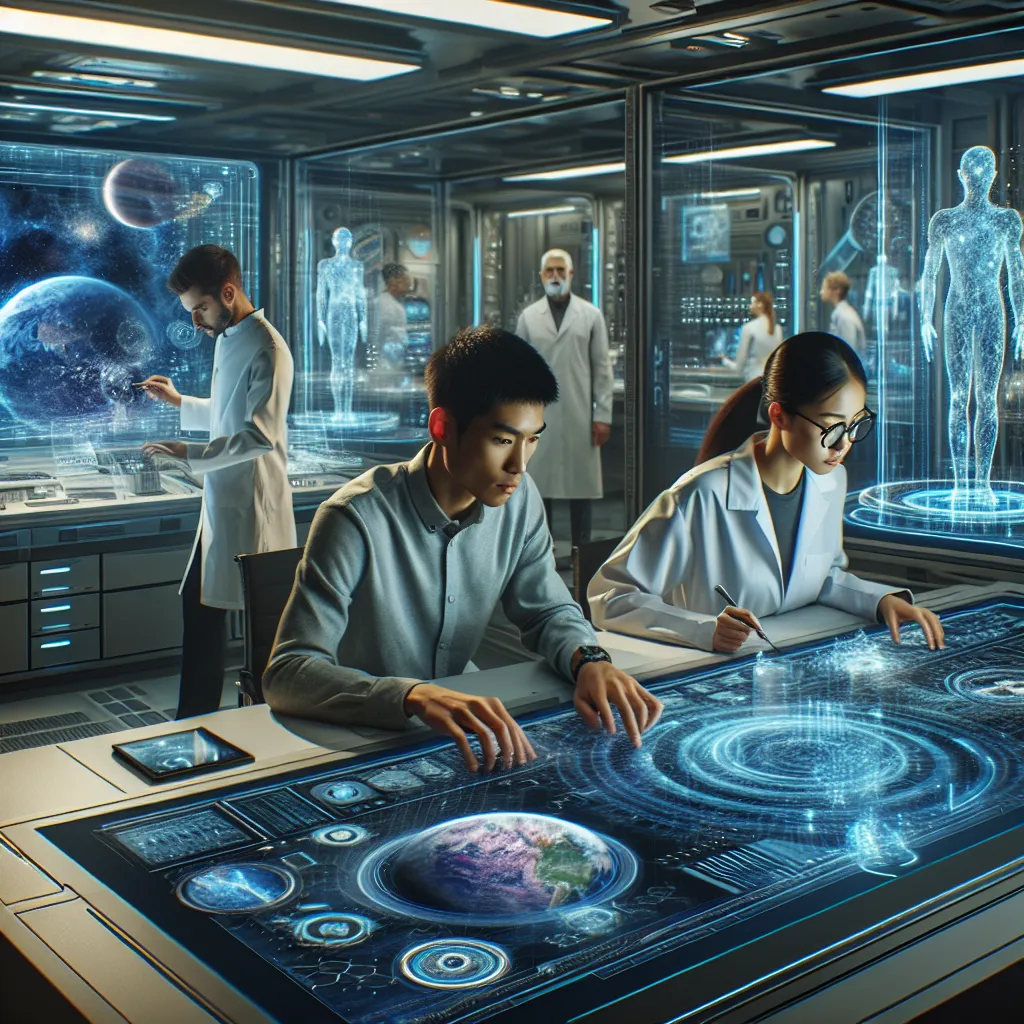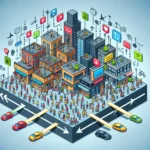Space exploration has been a driving force behind numerous scientific breakthroughs and technological advancements. In this IELTS Reading practice, we’ll explore the fascinating relationship between space exploration and scientific progress. Let’s dive into three passages of varying difficulty levels, followed by a range of question types to test your comprehension and analytical skills.
 Space exploration and scientific advancement
Space exploration and scientific advancement
Passage 1 – Easy Text
The Impact of Space Exploration on Earth-Based Technologies
Space exploration has been a catalyst for innovation since the dawn of the Space Age. Many technologies we take for granted today have their roots in space research. For example, the miniaturization of electronics, which led to the development of smartphones and laptops, was initially driven by the need to reduce the weight of spacecraft components.
Another significant contribution is in the field of medical imaging. The digital image processing techniques developed by NASA to enhance lunar and planetary photographs have been adapted for use in CT scans and MRI machines, revolutionizing medical diagnostics. Similarly, infrared ear thermometers, now commonly used in hospitals and homes, were originally designed to measure the temperature of distant stars.
Space exploration has also improved our understanding of Earth’s climate. Satellites equipped with advanced sensors provide crucial data on atmospheric composition, ocean currents, and polar ice caps. This information is vital for climate scientists studying global warming and developing strategies to mitigate its effects.
Furthermore, materials science has benefited greatly from space research. Lightweight, heat-resistant materials developed for spacecraft have found applications in various industries, from automotive to construction. For instance, memory foam, initially created to improve crash protection for aircraft passengers, is now widely used in mattresses and pillows.
In conclusion, while the primary goal of space exploration is to expand our knowledge of the universe, its impact on everyday life on Earth is undeniable. As we continue to push the boundaries of space exploration, we can expect even more technological breakthroughs that will benefit humanity in the years to come.
Questions 1-5
Do the following statements agree with the information given in the passage?
Write
TRUE if the statement agrees with the information
FALSE if the statement contradicts the information
NOT GIVEN if there is no information on this
- Space exploration has led to the development of smaller electronic devices.
- NASA’s image processing techniques are only used in space-related research.
- Infrared ear thermometers were initially designed for medical purposes.
- Satellites provide important data for climate change research.
- Memory foam was first developed for use in mattresses.
Questions 6-10
Complete the sentences below.
Choose NO MORE THAN TWO WORDS from the passage for each answer.
- The need to reduce the __ of spacecraft components led to the miniaturization of electronics.
- CT scans and MRI machines use __ techniques developed by NASA.
- Satellites equipped with advanced sensors collect data on atmospheric composition, ocean currents, and __.
- __ developed for spacecraft have applications in various industries.
- Space exploration is expected to lead to more __ that will benefit humanity in the future.
Passage 2 – Medium Text
Space Exploration: A Catalyst for Scientific Breakthroughs
The quest to explore the cosmos has been a driving force behind numerous scientific advancements, pushing the boundaries of human knowledge and technological capabilities. While the primary goal of space exploration is to unravel the mysteries of the universe, its far-reaching implications for scientific progress on Earth are often overlooked.
One of the most significant contributions of space exploration to scientific advancement is in the field of materials science. The extreme conditions of space, including vacuum, microgravity, and intense radiation, have necessitated the development of new materials with unprecedented properties. For instance, aerogels, initially created for space insulation, are now used in various terrestrial applications, from oil spill cleanup to building insulation. Similarly, carbon fiber composites, developed to withstand the rigors of space travel, have found widespread use in industries ranging from aerospace to sports equipment manufacturing.
The field of astronomy has been revolutionized by space-based observatories. Telescopes like the Hubble Space Telescope have provided unparalleled views of distant galaxies, nebulae, and exoplanets, free from the distortions caused by Earth’s atmosphere. These observations have led to groundbreaking discoveries, such as the accelerating expansion of the universe and the ubiquity of black holes in galactic centers.
Space exploration has also significantly advanced our understanding of fundamental physics. Experiments conducted in microgravity environments have allowed scientists to test theories and observe phenomena that would be impossible on Earth. For example, the Alpha Magnetic Spectrometer on the International Space Station is searching for evidence of dark matter and antimatter, potentially revolutionizing our understanding of the universe’s composition.
Moreover, the challenges of space exploration have spurred innovations in robotics and artificial intelligence. The development of autonomous rovers for planetary exploration has led to advancements in machine learning, computer vision, and sensor fusion technologies. These breakthroughs have applications far beyond space exploration, influencing fields such as autonomous vehicles and industrial automation.
The biomedical sciences have also benefited greatly from space research. Studies on bone density loss and muscle atrophy in astronauts have provided valuable insights into aging and degenerative diseases on Earth. Additionally, research on closed-loop life support systems for long-duration space missions has led to innovations in water purification and waste recycling technologies.
In conclusion, space exploration serves as a powerful catalyst for scientific advancement across a wide range of disciplines. As we continue to push the boundaries of space exploration, we can expect even more groundbreaking discoveries and technological innovations that will shape the future of science and improve life on Earth.
Questions 11-14
Choose the correct letter, A, B, C, or D.
-
According to the passage, which of the following is NOT mentioned as a condition in space that has led to the development of new materials?
A) Vacuum
B) Microgravity
C) Intense radiation
D) High pressure -
Which space-based instrument is specifically mentioned as searching for dark matter and antimatter?
A) Hubble Space Telescope
B) Alpha Magnetic Spectrometer
C) Carbon fiber composites
D) Aerogels -
What has the development of autonomous rovers for planetary exploration led to?
A) Advancements in materials science
B) Improvements in biomedical research
C) Progress in machine learning and computer vision
D) Discoveries about the expansion of the universe -
Studies on astronauts have provided insights into which of the following?
A) The composition of distant galaxies
B) The properties of black holes
C) The effects of aging and degenerative diseases
D) The development of new telescope technologies
Questions 15-19
Complete the summary below.
Choose NO MORE THAN TWO WORDS from the passage for each answer.
Space exploration has contributed significantly to scientific advancement in various fields. In materials science, new materials like 15__ and carbon fiber composites have been developed to withstand extreme space conditions. Space-based observatories have revolutionized astronomy by providing clear views of celestial objects without 16__ caused by Earth’s atmosphere. In physics, experiments in 17__ environments have allowed scientists to test theories impossible to verify on Earth. Space exploration has also driven innovations in 18__ and artificial intelligence, with applications in various industries. Additionally, biomedical research in space has provided insights into human health issues and led to advancements in 19__ technologies for long-duration missions.
Passage 3 – Hard Text
The Symbiosis of Space Exploration and Scientific Progress
The intricate relationship between space exploration and scientific advancement has been a subject of intense scrutiny and debate among scholars, policymakers, and the general public. While the astronomical costs associated with space programs have often been questioned, the cascading effects of space-related research and development on various scientific disciplines are undeniable and far-reaching.
One of the most profound impacts of space exploration on scientific progress lies in the realm of astrophysics and cosmology. The deployment of space-based observatories, such as the Hubble Space Telescope and the James Webb Space Telescope, has revolutionized our understanding of the universe. These advanced instruments have enabled scientists to peer into the farthest reaches of space and time, observing phenomena that were previously beyond the realm of human perception. The data collected from these missions have led to paradigm-shifting discoveries, including the accelerating expansion of the universe, the ubiquity of exoplanets, and the detection of gravitational waves. These findings have not only expanded our cosmic perspective but have also necessitated the revision of fundamental physical theories.
The technological spillovers from space exploration have been equally significant. The stringent requirements for reliability, efficiency, and miniaturization in space missions have driven innovations across a wide spectrum of technologies. For instance, the development of high-efficiency solar cells for spacecraft has directly contributed to advancements in renewable energy technologies on Earth. Similarly, the robust communication systems designed for deep space missions have led to improvements in global telecommunications infrastructure. The challenge of sustaining human life in the hostile environment of space has spurred research in life support systems, leading to breakthroughs in water purification, air filtration, and waste management technologies.
Moreover, space exploration has been instrumental in advancing our understanding of Earth sciences. Earth observation satellites provide crucial data on climate patterns, ocean currents, and atmospheric composition, enabling more accurate climate models and weather predictions. The holistic view of Earth as a complex system, first realized through space-based observations, has fundamentally altered our approach to environmental science and resource management.
The biomedical sciences have also reaped substantial benefits from space research. Microgravity experiments conducted on space stations have provided unique insights into cellular biology, protein crystallization, and physiological adaptations to extreme environments. These studies have implications for understanding and treating diseases such as osteoporosis, muscle atrophy, and balance disorders. Furthermore, the development of telemedicine and remote health monitoring systems for astronauts has led to innovations in healthcare delivery, particularly in remote and underserved areas on Earth.
The interdisciplinary nature of space exploration has fostered unprecedented collaboration among diverse scientific fields. The convergence of astronomy, physics, biology, and engineering in space missions has catalyzed cross-pollination of ideas and methodologies. This synergistic approach has not only accelerated scientific progress but has also given rise to entirely new fields of study, such as astrobiology and space medicine.
However, it is important to acknowledge that the relationship between space exploration and scientific advancement is not unidirectional. Terrestrial scientific progress often enables and enhances space exploration capabilities. Advancements in computer science, materials engineering, and nanotechnology, for example, have been crucial in developing more sophisticated and efficient space technologies.
In conclusion, the symbiosis between space exploration and scientific advancement is a complex and multifaceted phenomenon. While the immediate benefits of space programs may not always be apparent, their long-term impact on scientific progress and technological innovation is profound and far-reaching. As we continue to push the boundaries of space exploration, we can anticipate even more groundbreaking discoveries and technological breakthroughs that will shape the future of science and human civilization.
Questions 20-23
Choose the correct letter, A, B, C, or D.
-
According to the passage, which of the following is NOT mentioned as a discovery enabled by space-based observatories?
A) The accelerating expansion of the universe
B) The ubiquity of exoplanets
C) The detection of gravitational waves
D) The composition of Earth’s core -
What has the development of high-efficiency solar cells for spacecraft contributed to on Earth?
A) Improvements in global telecommunications
B) Advancements in renewable energy technologies
C) Breakthroughs in water purification
D) Innovations in healthcare delivery -
Which field of study is mentioned as having emerged from the interdisciplinary nature of space exploration?
A) Astrophysics
B) Environmental science
C) Astrobiology
D) Nanotechnology -
How does the passage describe the relationship between space exploration and terrestrial scientific progress?
A) Space exploration always leads terrestrial scientific progress
B) Terrestrial scientific progress has no impact on space exploration
C) The relationship is unidirectional from space to Earth
D) Terrestrial scientific progress often enables and enhances space exploration capabilities
Questions 24-26
Complete the sentences below.
Choose NO MORE THAN TWO WORDS from the passage for each answer.
- The data collected from space-based observatories have led to __ that have expanded our cosmic perspective.
- Earth observation satellites provide crucial data for creating more accurate __ and weather predictions.
- Microgravity experiments on space stations have provided insights into cellular biology, protein crystallization, and __ to extreme environments.
Questions 27-30
Do the following statements agree with the claims of the writer in the passage?
Write
YES if the statement agrees with the claims of the writer
NO if the statement contradicts the claims of the writer
NOT GIVEN if it is impossible to say what the writer thinks about this
- The cost of space exploration programs is justified by their scientific benefits.
- Space-based observations have changed our approach to environmental science.
- All scientific fields have benefited equally from space exploration.
- The future of space exploration depends entirely on terrestrial scientific progress.
Answer Key
- TRUE
- FALSE
- FALSE
- TRUE
- FALSE
- weight
- digital image processing
- polar ice caps
- Lightweight, heat-resistant materials
- technological breakthroughs
- D
- B
- C
- C
- aerogels
- distortions
- microgravity
- robotics
- life support
- D
- B
- C
- D
- paradigm-shifting discoveries
- climate models
- physiological adaptations
- NOT GIVEN
- YES
- NOT GIVEN
- NO
Tips for Achieving a High Score in IELTS Reading
To excel in the IELTS Reading section, consider the following advice:
-
Improve your reading speed: Practice reading various texts quickly while maintaining comprehension. This skill is crucial for managing time effectively during the test.
-
Develop skimming and scanning techniques: Learn to quickly identify main ideas (skimming) and locate specific information (scanning) in texts. These skills are essential for answering questions efficiently.
-
Expand your vocabulary: Regularly learn new words and their contextual usage. A broad vocabulary will help you understand complex texts more easily. You can find useful vocabulary lists on our website, such as those related to describing interesting jobs or remarkable achievements.
-
Practice with various question types: Familiarize yourself with all question formats used in IELTS Reading. Each type requires a different approach, so practice is key to mastering them all.
-
Read actively: Engage with the text by underlining key points, making mental notes, and predicting what might come next. This approach enhances comprehension and retention.
-
Manage your time wisely: Allocate your time effectively among the three passages. If you’re struggling with a question, move on and return to it later if time permits.
-
Pay attention to context: Understanding the overall context of a passage can help you infer the meaning of unfamiliar words and phrases.
-
Learn to paraphrase: Questions often rephrase information from the text. Practice recognizing ideas expressed in different words.
-
Stay focused: Maintain concentration throughout the test. If you lose focus, take a brief moment to recompose yourself before continuing.
-
Review and double-check: If time allows, review your answers. Pay special attention to questions you were unsure about initially.
Remember, consistent practice is key to improving your IELTS Reading score. Utilize resources like IELTS.NET for additional practice materials and expert guidance. By following these tips and dedicating time to regular practice, you’ll be well-prepared to tackle the IELTS Reading section with confidence.
For more insights into the IELTS exam and preparation strategies, you might find our article on the role of space exploration in scientific advancement helpful. It provides a deeper look into this fascinating topic, which could be valuable for both your IELTS preparation and general knowledge.


